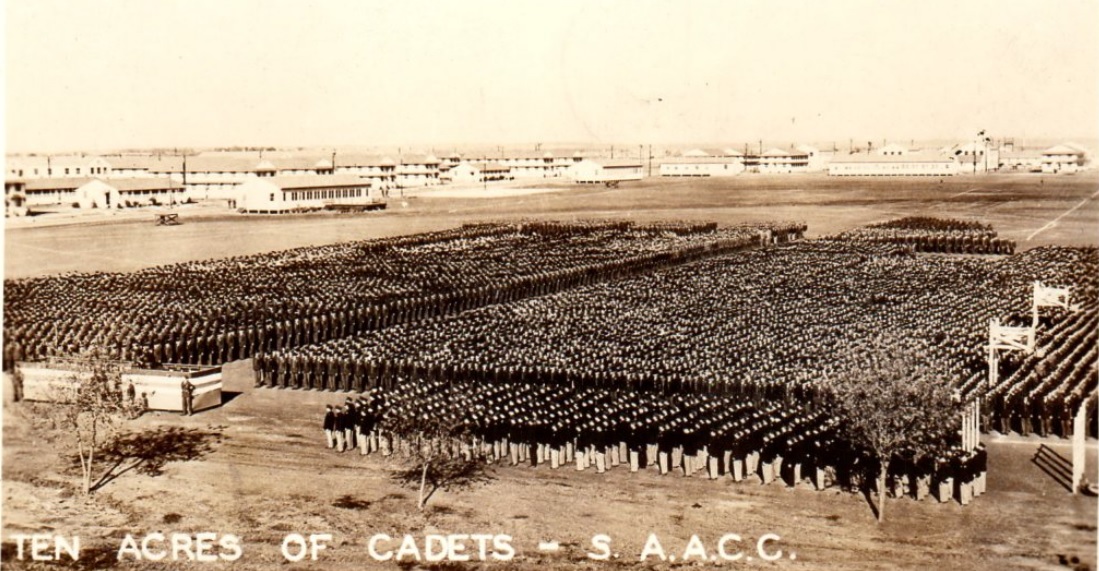JOINT BASE SAN ANTONIO-RANDOLPH, Texas — Air Education and Training Command, the U.S. Air Force’s oldest active command, marks its 79th anniversary Jan. 23, 2021, making it the First Command as well as the first command to which Airmen are assigned.
AETC traces its roots to the Air Corps Flying Training Command, which was activated nearly eight decades ago on Jan. 23, 1942.
The first iteration of AETC flying training was consolidated under then-Vice Chief of the Air Corps Lt. Gen. Barton K. Yount. With an urgent, operational need for even greater authority and direction during World War II, technical training was folded into Yount’s command in July 1943.
According to the command’s history, the earliest Airmen learned their trades outside the service with little standardization and institutional control. Much of training was decentralized and executed by contractors. Formal training was accomplished at Chanute Air Force Base in Illinois, or then Randolph AFB, or accomplished by training on-the-job. It was not until World War II and the expansion of American air frames, that training was scaled to win the largest air war of all time, and the beginnings of the First Command’s enduring legacy was cemented in history we celebrate today.
By the end of World War II in 1945, the command had produced nearly 200,000 pilots, 48,000 navigators and aircrew, 1.9 million technical training graduates, and 2.8 million basic military training graduates—Airmen who proved decisive in every theater of war and dominated the world’s skies.
To accommodate this unprecedented expansion, BMT and flight schools were expanded and geographically dispersed, according to Gary Boyd, AETC command historian. Midwesterners would find themselves on a train to then-Sheppard Field, complete indoctrination training, and then begin airplane and engine mechanics school at a neighboring facility before proceeding to a nearby factory for a technical rating, he said.
 On July 1, 1946, Army Air Forces Training Command became Air Training Command. The early Airmen of the command oversaw the world’s most complex technical training and flying program before becoming part of the newly-formed U.S. Air Force in September 1947.
On July 1, 1946, Army Air Forces Training Command became Air Training Command. The early Airmen of the command oversaw the world’s most complex technical training and flying program before becoming part of the newly-formed U.S. Air Force in September 1947.
According to Boyd, the anticipated peace dividend following World War II ended quickly, and ATC began a surge in readiness and operations in response to world events. ATC earned its reputation as the premier training establishment of the world’s air forces and the most successful and flexible industrial scale training operation of all time. Instructors trained Airmen on emerging technologies like computers and missiles, while providing the essential instruction on standard courses of study from basic flight training to medical administration.
On July 1, 1993, Air University merged with ATC and the command was renamed Air Education and Training Command.
According to command history, while the force inevitably reduced during peacetime operations, the mission became even more robust. Distance learning, cyber warfare and expeditionary training throughout AETC evolved with the advent of technological innovations, and its Airmen continued to train for the 21st century.
During 2020, innovative approaches to developing Airmen took center stage, including the integration of advanced capabilities, technology, and Airmen-centric instruction to expeditiously develop high-quality Airmen, made this past year one of the most momentous in the command’s history, said Chief Master Sgt. Erik Thompson, AETC command chief.
“Our successes this year are directly attributed to the tactical leadership of our instructors, educators, medical professionals, support personnel, and all those who had a hand in training and educating across our command,” said Thompson. “We could not have overcome the challenges we have faced without an innovative, dedicated force, who have fought through adversity, day-in and day-out to make the mission happen.”
At the onset of the COVID-19 pandemic, AETC members were essential to continuing to recruit, train and educate the force during unprecedented times, said Boyd.
“AETC’s most noteworthy feat this year was fighting through the pandemic and doing it safely,” Boyd said. “Many plans envisioned halting training operations during the pandemic, but the command’s leadership realized immediately that the lethality of the Air Force depended on the continuation of the pipeline. The command looked to the past and stood up an additional BMT location, as it had done in the ‘50s and ‘60s. Flying training was modularized to allow for social distancing, quarantine protocols and distance learning. AETC instilled confidence to the rest of the Air Force and organizations who watched members of the command in action. AETC showed, as it always does, what right looks like.”
Another noteworthy training milestone this past year has been the command’s increased efforts to improve opportunities for all Airmen and potential recruits. In 2020 alone, AETC officials sponsored several policy changes to cultivate a diverse and inclusive force—updating anthropometric guidance to accurately reflect the nation’s population, eliminating height requirement waivers, and reducing restrictions on pregnant Airmen who perform flight duties, to name a few.
“The greatest evolution in training has been increasing opportunities for all Airmen,” Boyd said. “Every year our command removes more barriers and is thus more capable, because of the strengths that a dynamic and diverse population of Airmen bring to the fight.”
Today, AETC continues to build on its incredible heritage as the First Command, marked by exceptional Airmen and dedicated professionals who are ready to perform the mission anywhere, anytime, said Lt. Gen. Brad Webb, AETC commander.
"This year has been marked by our incredible efforts to advance force development and transform learning to discover, develop, and deliver lethal, ready Airmen and Guardians,” said Webb. “We are proud that today’s force stands on the shoulders of bold Airmen that came before us, and we look to the future with clear eyes, charged with accelerating change and maintaining our warfighting competitive advantage."